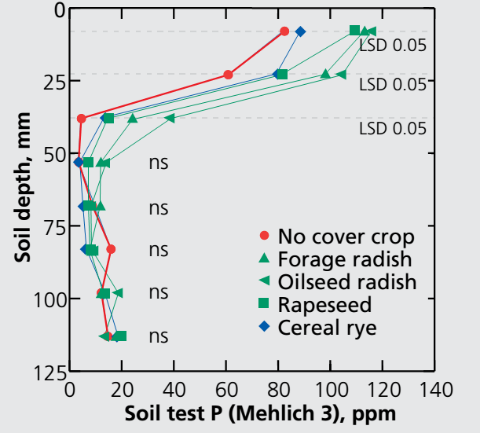Does strategic tillage help minimize the impact of phosphorus stratification on crop yields in no-till farming?
Some farmers wonder if strategic tillage, i.e., occasional tillage (for example every 10 years), of their long-term no-till (NT) field to manage some undesirable impact is necessary.
What impact does one-time tillage after a long period of no-till have on my soil and yields? These concerns were raised due to stratification of P (accumulation near soil surface) within the top soil and in some cases pH, weed prevalence, and soil compaction.
Nutrient stratification: Due to placement and very low mobility in soil, nutrients like P, K, and Zn accumulate in the top 3 or 4 inches of soil in long-term NT. When the topsoil is very dry, stratification can lead to low P uptake. But positive yield responses to the practice of a one-time tillage strategy for long-term NT fields have been inconsistent and only temporal.
Some reports indicate that one-time tillage reduces P loss in top soil because it distributes P to lower depths, and probably because tillage increases the capacity for P to bind strongly to soil within the plowed layer. This is not a serious concern for the farmers because long-term NT enhances soil aggregation, and maintains residue on the surface of soil which should reduce soil loss with P. Tillage on erosion susceptible soils should create more long-term problems.

Natural stratification has even been reported, where cover crops recycle sub-soil P to the top soil (Figure. Results from Weil and Graduate Students, in Grove et al., http://agronomypro.com/Nutrient-Stratification-No-till-Soils.pdf ).
How would one-time tillage affect weed control? Conventional tillage buries weeds below depths of emergence; but introduction of tillage in a long-term NT plot also breaks seed dormancy, and can move buried viable weed seeds to the soil surface.
Should I band or broadcast fertilizer under no-till?
Applying P fertilizer by broadcast is easier but the practice is a cause for P stratification. Banding near the seed can reduce fixation and increase uptake early in the season. Deep banding of P reduces stratification near soil surface. Soil sampling in NT following years of fertilizer banding would require more soil samples per field for analysis to better represent the entire field.
Application of starter P or deep banding favors better yields for corn. The 2x2 banding with starter P for corn and broadcast P for soybeans are encouraged in ND. Meanwhile, banding P and K is more critical for small grains since they have limited rooting systems and therefore less capacity to explore large soil volumes. In addition, with shorter growth cycles that begin in early spring with cooler temperatures, banding near the seed can reduce P fixation and enhance uptake with the result of about 10% yield increase in wheat.
Single tillage every other decade or so may not provide any long-term economic benefits in view of the N credits and savings when calculating N fertilizer rates in under long-term no till.
Jasper M. Teboh
Soil Scientist


